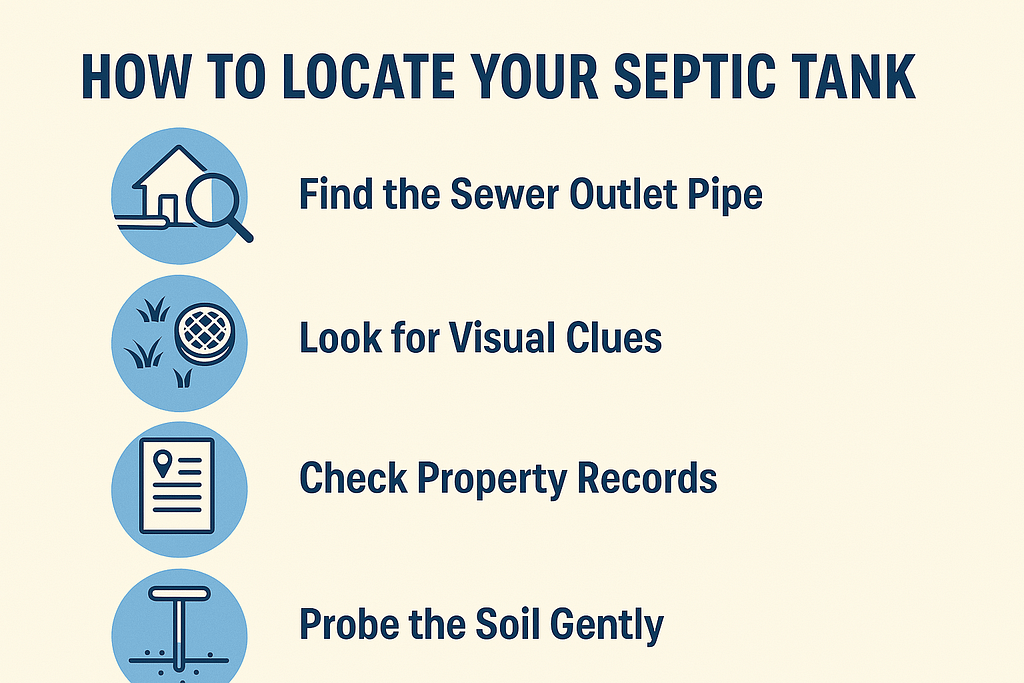How to Locate Your Septic Tank Without Digging (Yes, It’s Possible)
How to Locate Your Septic Tank Without Digging (Yes, It’s Possible)
If you’re like most homeowners with a septic system, you probably know you have one—but don’t know exactly where it is. The idea of wandering around your yard with a shovel might sound like a nightmare. Good news: There are easier ways to find your septic tank without destroying your lawn.
Let’s break down how to locate your septic tank using simple clues, free records, and a little detective work—no backhoe needed.
🧭 Why You Need to Know Where Your Septic Tank Is
- It helps with regular maintenance (like pumping).
- It’s essential during inspections or when selling your home.
- It saves $$$ during emergencies.
“We didn’t know where our tank was until sewage backed up. The pros had to dig up half our yard to find it,” says Mark from Vermont. “Now we have it mapped and flagged. Lesson learned.”
Knowing where your tank is located is step one in septic care. If you haven’t already, check out our full guide on how to baby your septic tank.
🔍 Step-by-Step: How to Find Your Septic Tank Without Digging
1. Follow the Main Sewer Line
Go into your basement or crawl space and find where the main sewer line exits your home. Usually, it’s a 4-inch pipe heading through the foundation.
Stand outside, directly opposite that wall. The tank is often buried 10–25 feet straight out from that exit point.
2. Look for Low Spots or Lush Grass
Subtle dips in your yard or areas of unusually green grass could hint at buried septic components. The tank might be under that greener patch (but note: this could also be a red flag of leakage).
3. Check for Sewer Cleanouts
Some homes have a white plastic or cast iron pipe with a cap sticking slightly out of the ground—that’s a cleanout and often marks the path to the tank.
4. Access Your County’s Septic Records
Many counties keep septic tank maps, drawings, or permitting records. Call your local health department or check their online portal.
“Our county had a septic layout from 1992. It had exact measurements from our foundation to the tank,” says Julie in Georgia. “Huge time saver!”
5. Use a Septic Tank Locator Tool (Probe or Flushable Locator)
A simple metal soil probe can help you feel out the tank lid 1–3 feet underground. Or, flush a radio-transmitting locator device (sold at hardware stores), then scan your yard with the receiver.
6. Ask the Previous Owner (or Neighbors)
If you bought recently, check your closing documents. Otherwise, a quick chat with a neighbor who has a similar setup might give you a shortcut.

🗺 Pro Tip: Mark It for the Future
Once you find it, flag the area, snap a photo, and draw a map. Store it with your home maintenance records or digitally in a cloud folder.
🚫 What NOT to Do When Looking for a Septic Tank
- ❌ Don’t start digging randomly—you might hit pipes.
- ❌ Don’t rely on guesses from contractors unfamiliar with septic systems.
- ❌ Don’t ignore the signs of tank problems while searching—check out our article on septic warning signs and solutions.
✅ Next Steps: Maintain It Like a Pro
Now that you’ve found your tank, don’t stop there:
- Schedule a pumping if it’s been 3–5 years.
- Avoid flushing non-biodegradable items.
- Check out our full guide to septic system care.
Your septic tank deserves some love, and your lawn will thank you for not tearing it up to find it.
Once you’ve found it, make sure you’re maintaining it. Read our full septic system care guide
Need help or want to mark your tank professionally? Contact your local septic service provider and ask about tank locating and mapping.



